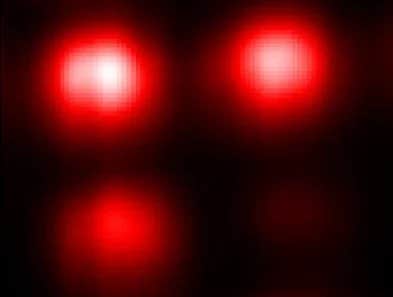Quantum state of electrons measured for the first time ever
The photoelectric effect, first explained in 1905, transformed our understanding of how light interacts with matter.

Image from the laser lab used in the research. (CREDIT: Charlotta Carlberg Bärg)
The photoelectric effect, first explained in 1905, transformed our understanding of how light interacts with matter. When high-energy light hits atoms, it knocks electrons loose. This process powers tools like holography, spectroscopy, and electron microscopes. But despite its importance, the full quantum behavior of those freed electrons has stayed out of reach—until recently.
Researchers at Lund University in Sweden have changed that. For the first time, they’ve managed to measure the quantum state of electrons emitted by atoms when struck by high-energy light. Their breakthrough offers a new level of detail in how light and matter exchange energy.
“By measuring the quantum state of the photoelectron, our technique can precisely address the question of ‘how quantum is the electron,’” says David Busto, an associate senior lecturer in atomic physics and co-author of the study.
The team’s results, published in Nature Photonics, could push forward several scientific areas. Fields like material science, atomic physics, and quantum mechanics may soon benefit from this clearer view of electron behavior at the smallest scales.
Quantum Behavior of Photoelectrons
At the quantum level, electrons aren’t just particles—they also behave like waves. This dual nature makes them tricky to describe. But with this new method, researchers can now reconstruct the quantum state of photoelectrons with high accuracy. It’s a major step forward in tracking how electrons act when they leave atoms.
Ionization happens when ultraviolet or X-ray light hits atoms or molecules and causes electrons to break free. By measuring the kinetic energy and momentum of these ejected electrons, scientists learn about the material’s atomic structure. This process is the foundation of photoelectron spectroscopy, developed in the 1980s by Nobel Prize winner Kai Siegbahn.
Earlier versions of this technique focused on classical data—mainly how fast and in what direction electrons traveled. But this Swedish team has taken things further. Their new method doesn’t just look at classical traits—it captures the full quantum state. That unlocks a layer of information that was hidden until now.
Related Stories
Unlocking Quantum Information
The team’s technique uses a process similar to a CT scan. Just as multiple 2D X-ray images reconstruct a 3D representation of an organ, this new method takes snapshots of the photoelectron’s state from different angles, building a complete quantum picture. The process involves ionizing helium and argon atoms with ultrashort, high-energy light pulses, followed by an analysis using two laser pulses of different colors.
This breakthrough demonstrates that the quantum state of a photoelectron depends on the material from which it originates. Understanding these differences is crucial, as it could impact multiple scientific domains.
“The photoelectric effect was explained over a century ago by Einstein, laying the foundation for quantum mechanics. This same phenomenon was then exploited by Kai Siegbahn to study how electrons are arranged inside atoms, molecules, and solids,” Busto notes.
More than 40 years after Siegbahn’s Nobel Prize, this new method extends the potential of photoelectron spectroscopy by enabling full characterization of the quantum properties of emitted electrons. It provides access to previously unattainable quantum information, refining our understanding of atomic and molecular behavior.
Applications and Future Potential
Beyond fundamental physics, this discovery has far-reaching implications. The ability to measure photoelectron quantum states could lead to advancements in atmospheric photochemistry, material science, and even solar energy research.
“We applied our technique to simple atoms like helium and argon, which are relatively well understood. In the future, it could be used to study molecular gases, liquids, and solids,” Busto explains. “Understanding how the ionized target reacts after losing an electron could have a long-term impact on various fields.”
For instance, solar cells and photosynthesis rely on light-harvesting systems that convert energy at the quantum level. The new technique could help scientists better understand and optimize these systems.
This study also bridges two scientific disciplines: attosecond science and quantum information technology. It aligns with the broader goals of the ongoing second quantum revolution, which seeks to manipulate individual quantum objects for advanced applications.
While this breakthrough won’t directly lead to quantum computers, it offers physicists a powerful tool to fully exploit quantum properties in future technologies. “By measuring the speed and emission direction of the photoelectron, we can learn a lot about the structure of materials,” says Busto. “Our technique goes beyond previous methods by measuring the complete quantum state, unlocking information that traditional photoelectron spectroscopy could not access.”
The Road Ahead
The results have already surprised researchers. Measuring quantum states of photoelectrons had been attempted before, but previous methods struggled with stability issues. “The most surprising aspect is that our technique worked so well,” Busto admits. “Physicists had tried this before using different methods, and it was very challenging. Everything had to remain extremely stable for long periods, but we finally managed to achieve it.”
This stability is crucial, as the process of decoherence—the loss of quantum properties due to external interactions—poses a major hurdle in quantum research. At microscopic scales, electrons, atoms, and molecules obey quantum mechanics, while macroscopic objects follow classical physics. The transition between these two realms is still not fully understood.
As researchers refine this technique, they hope to track how electrons evolve from quantum to classical states over time. The new method, named KRAKEN, could provide key insights into decoherence, furthering the development of quantum technologies.
“The electrons emitted during the photoelectric effect contain a wealth of information about the irradiated material,” Busto says. “By measuring their quantum state, we can follow their evolution and better understand how quantum effects transition into classical physics.”
This discovery represents a leap forward in our ability to probe the quantum world. By unlocking the full quantum description of photoelectrons, scientists are not just refining existing technologies—they are expanding the boundaries of what is possible in quantum science.
Note: Materials provided above by The Brighter Side of News. Content may be edited for style and length.
Like these kind of feel good stories? Get The Brighter Side of News' newsletter.



